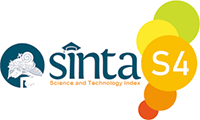Public Trust in Acupuncture as Complementary Medication in Private Nurse Latu Usadha Clinic Abiansemal Badung
Kepercayaan Masyarakat Terhadap Pengobatan Komplementer Akupuntur di Praktik Perawat Mandiri Latu Usadha Abiansemal Badung
DOI:
 https://doi.org/10.36376/bmj.v8i1.157
https://doi.org/10.36376/bmj.v8i1.157
Keywords:
Acupuncture, Public Trust, ComplementaryAbstract
Background: Complementary therapy is a form of non-conventional medication or treatment that comes from various systems, modalities and health care practices based on theory and belief. Non-conventional treatments are often successful when the conventional ones are unsuccessful and have mild side effects that can be detrimental to the patient. Acupuncture is a complementary therapy that works as an effort to optimize health services. Specifically, acupuncture is a method of treatment by inserting needles into acupuncture points of the body. In regards to planning and identifying the care needed by patients, it is necessary to study how public trust in acupuncture as complementary medication more deeply. Objective: This study examines how public trust are built in complementary acupuncture medication. Methods: This study uses qualitative methods. The instrument used is an in-depth interview. Data collection was carried out in March-May 2020. The informants in this study were 10 patients who did acupuncture therapy. Additionally, informants were selected randomly (randomization). In regards to assess the informants' experience, researchers used a Likert scale. Findings and discussion: Results and Discussion: The majority of the informants had very good experience with acupuncture treatment. Some internal factors that influence people's trust in applying complementary acupuncture medication are belief / tradition, perception and knowledge, while the external factors are economical, culture, employment, income and family support. Conclusions and Suggestions: Promotion and development of complementary health services for acupuncture can be done more effectively and innovatively. Thus, people are provided with options of the health services they prefer.
Downloads
References
Departemen Pendidikan Nasional. (2005). Kamus Besar Bahasa Indonesia. Jakarta: Balai Pustaka.
Dharmojono. (2001). Menghayati Teori & Praktek Akupunktur & Moksibasi. Jakarta: Trubus Agriwidya.
Foster, & Anderson. (1986). Antropologi Kesehatan. Jakarta: UI Press.
Kamaluddin, R. (2010). Pertimbangan dan Alasan Pasien Hipertensi Menjalani Terapi Alternatif Komplementer Bekam di Kabupaten Banyumas. Jurnal Keperawatan Soedirman, 5(2), 95–104. Retrieved from http://jks.fikes.unsoed.ac.id/index.php/jks/article/view/276/151
Kementerian Kesehatan Republik Indonesia. Peraturan Menteri Kesehatan Republik Indonesia nomor 37 tahun 2017 tentang Pelayanan Kesehatan Tradisional Integrasi. , (2017). Indonesia.
Krisnawati, A. (2012). Faktor-Faktor yang Mempengaruhi Kunjungan Pasien di Klinik Alternatif Akupuntur Yogyakarta Tahun 2012 (Sekolah Tinggi Ilmu Kesehatan ’Aisiyah Yogyakarta). Sekolah Tinggi Ilmu Kesehatan ’Aisiyah Yogyakarta. Retrieved from http://digilib.unisayogya.ac.id/1479/1/NASKAH PUBLIKASI_ATUN KRISNAWATI
Kusuma, A., & Kiswojo. (1978). Teori dan Praktek Ilmu Akupunktur. Jakarta: Gramedia.
Notoatmodjo, S. (2003). Ilmu Kesehatan Masyarakat. Jakarta: Rineka Cipta.
Notoatmodjo, S. (2007). Prinsip - Prinsip Dasar Promosi Kesehatan & Ilmu Perilaku. Jakarta: Rineka Cipta.
Purwanto, N. (1996). Psikologi Pendidikan. Bandung: Remaja Rosdakarya.
Saputra, K. (2002). Akupunktur Klinik. Surabaya: Airlangga Press.
Saputra, K. (2005). Akupunktur Dasar. Surabaya: Airlangga University Press.
Saputra, K. (2012). Akupunktur dalam Pelayanan Kesehatan tingkat Rumah Sakit. OPINI, 39(10), 780–782.
Setyaningsih, Y. (2012). Hubungan Antara Persepsi dengan Sikap Masyarakat Terhadap Pengobatan Komplementer di Kecamatan Grogol Kabupaten Sukoharjo. Universitas Muhammadiyah Surakarta.
Sukanta, P. O. (2008). Pijat Akupresure untukKesehatan. Jakarta: Penebar Plus.
Supriadi. (2014). Determinan Perilaku Pencarian Pengobatan Tradisional (Tradisional Medication) Masyarakat Urban Cengkareng Jakarta Barat Tahun 2014. Universitas Islam Negeri Syarif Hidayatullah.
Turana, Y. (2009). Seberapa Besar Manfaat Pengobatan Alternatif. Retrieved February 10, 2020, from medikaholistik website: www.medikaholistik.com
Windridge, C. (1999). Tong Sing The Chinese Book of Wisdom. London: 122 Arlington.
Zulkifli. (2005). Pengantar Studi Ilmu Administrasi dan Manajemen. Pekanbaru: UIR Press.
Downloads
Published
How to Cite
Issue
Section
License
Copyright (c) 2021 Kadek Sri Ariyanti, Made Dewi Sariyani, Cokorda Istri Mita Pemayun

This work is licensed under a Creative Commons Attribution 4.0 International License.


















